230 results
Astronomy laboratories for Microsoft Word

Tides Lab Using Water Balloons - Hands On Experience That Kids LOVE!
This lab is a really fun way to use discovery and investigation to teach students how gravity and inertia cause tides, along with the moon. The cost is low (a package of water balloons and yarn) and it is a great activity to get kids moving and outside. They work in small groups and go through a series of steps and procedures and record data. This was one of the most fun labs of the year for students and was instrumental is having kids understand why we have high tides on the side of the Earth c
Subjects:
Grades:
6th - 12th
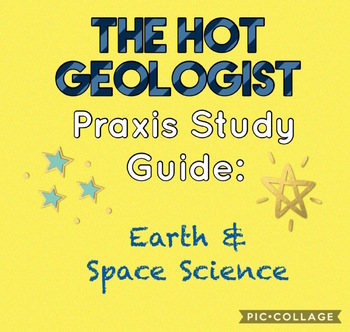
Earth Science Praxis Exam Study Guide
Need to get the extra certification to become more qualified? Say no more!
I made this study guide based on the PDF from the Praxis site: https://www.ets.org/s/praxis/pdf/5571.pdf
Includes all test specifications and sections needed to know for the exam!
> I passed for my state standards from studying this study guide I made! Good luck, studying one page a day helps!
MY STUDY TIPS:
• Study every day.
• Study a page a day, and also go back to old material to refresh.
• Pick a time of
Subjects:
Grades:
7th - 12th
Types:
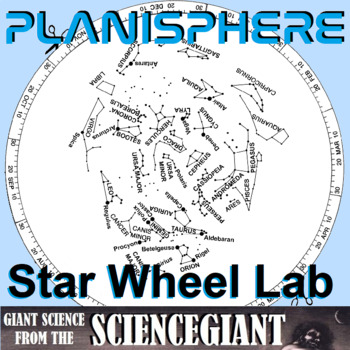
Planisphere Lab Activity: A Star Wheel for Constellation Exploration
Inexpensive and ingenious! Planispheres are a unique tool for learning astronomy: a make-it-yourself star map, adjustable for any time of night in any month of the year. They are designed to show the position of prominent constellations in the night sky. It's a low-tech way for Ss to learn the location (and thus give meaning to key vocabulary terms) of the horizon, zenith, meridian, ecliptic and celestial equator on the celestial sphere. This lab includes two types of planispheres: one for stan
Subjects:
Grades:
6th - 12th, Higher Education
Types:
NGSS:
HS-ESS1-4
, 5-ESS1-2
, MS-ESS1-1
Also included in: StayGiant Earth Science Bundle: Astronomy (space exploration)
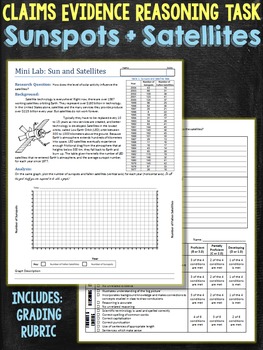
Lab Activity Effect of Sunspots on Satellites (Claims Evidence Reasoning Task)
A short lab activity for astronomy or earth space science. Students make a double line graph of the number of sunspots and the number of crashed satellites in a given year. Then they look for patterns and write a science conclusion utilizing claim, evidence, reasoning scaffolding framework.
Grading rubric and sample student responses are included
This lab activity blends well into a unit on electromagnetic waves, planetary mechanics, or the Sun's influence on Earth.
Subjects:
Grades:
7th - 12th, Higher Education
Types:
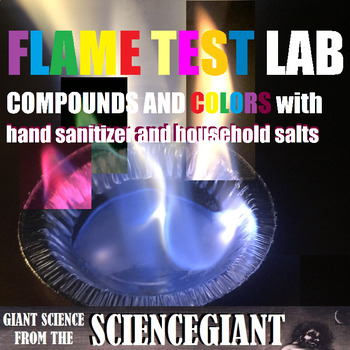
Flame Test Lab of Compounds and Colors with hand sanitizer and household salts
Flame Test of Compounds and Colors is a low cost lab demonstration to fire up your students. This chemistry lab uses hand sanitizer and household chemicals of sodium chloride (table salt), potassium chloride (salt substitute), sodium borate (insecticide with borax acid) and potassium hydrogen tartare (cream of tartar) in a safe and fun fiery introduction to compounds! Excite electrons and ignite your students interest in elements with this demonstration of red, orange, yellow, green, blue, and p
Subjects:
Grades:
7th - 12th
Types:
NGSS:
HS-PS4-1
, HS-PS4-3
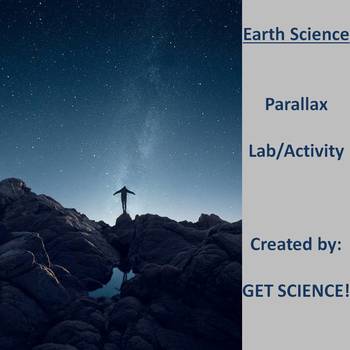
Understanding Parallax
This lab makes understanding parallax simple. Students use real world examples and draw so that parallax can be visualized. The concept is reinforced throughout. A summary YouTube video is included. My students completely understood the concept after this lab!You may edit this lab, the answer key is provided.Educating the World Together!Get Science
Subjects:
Grades:
8th - 12th, Higher Education
Types:
Also included in: Astronomy Lab Bundle
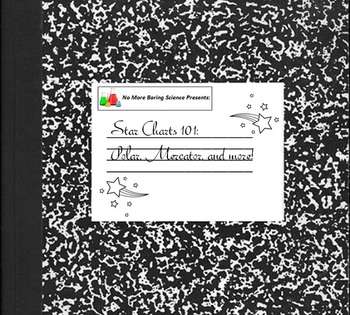
Astronomy/Earth Science Lab Series - Using Star Charts to find Constellations
New from No More Boring Science - How to use star charts! The focus of this lab is to help students gain confidence using star charts to find constellations. There are two activities in this lab: using a polar star chart map to find constellations on a blank section of the sky, and then translating constellations from a polar projection map to a mercator projection map. The first activity is more advanced than the second, but all maps and charts are included. Keys are included as well!
If you l
Subjects:
Grades:
7th - 12th, Higher Education, Adult Education
Types:
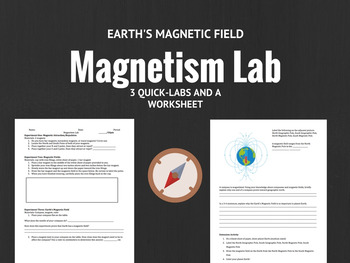
Magnetism Lab - Earth's Magnetic Field
***Editable***
Use these three quick-labs to explore magnetism! Three labs with an accompanying worksheet will astound your students and teach them about magnetism as well as the Earth's magnetic field. Prior knowledge required when exploring the worksheet on Earth's magnetic field.
Labs require the following materials: iron filings, bar magnets, a compass, and a ruler
Subjects:
Grades:
4th - 8th
Types:
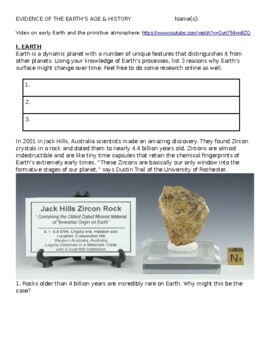
HS-ESS1-6: Age of Earth and Moon Formation NGSS Activities
This NGSS-aligned resource is meant for an Earth and Space science course or Astronomy course. Students will engage with labs, quantitative and visual data, videos, and scientific texts to gather evidence regarding the age of the Earth as well as the formation of the moon. This series of guided activities should take roughly two or three class periods. Students will develop a fuller understanding of Earth's early history and age and why it is such a unique, dynamic planet. Students will complete
Subjects:
Grades:
9th - 12th
Types:
NGSS:
HS-ESS1-6
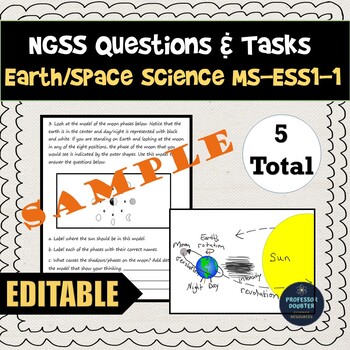
NGSS Assessment Tasks and Test Question MS-ESS1-1 Model Earth Sun Moon System
NEW! This resource contains quality, EDITABLE sample NGSS assessment questions and performance tasks for the Earth and Space Sciences Performance Expectation MS-ESS1-1 Develop and use a model of the Earth-sun-moon system to describe the cyclic patterns of lunar phases, eclipses of the sun and moon, and seasons. It includes 5 questions or tasks total which can be edited, copied and pasted into various forms of assessments to align to the NGSS. Use these sample questions for: pre-assessments, chec
Subjects:
Grades:
6th - 9th
Types:
NGSS:
MS-ESS1-1
Also included in: NGSS Middle School Science Activities and Lessons Growing MEGA Bundle
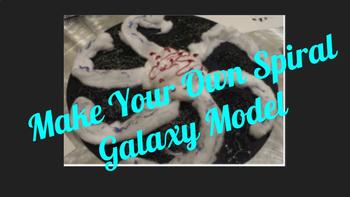
Milky Way Galaxy Model Lab
Students will make a model of the milky way or spiral galaxy using glue, 8 large cotton balls, and glitter glue. The glitter glue is to show old and new stars (red ad blue) and the cotton balls are to make the spiral arms and the 'bulge' in the middle of the galaxy! There are follow up questions on the back of the lab sheet for students to answer after they have made their model.
Subjects:
Grades:
Not Grade Specific
Types:
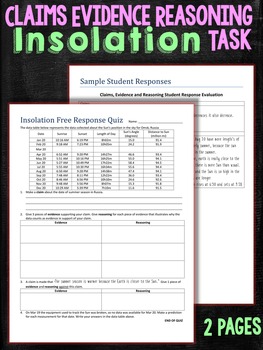
Claims Evidence Reasoning Task Insolation Seasons Quiz Assessment
Assessment task used to measure students ability to come up with a claim then support it with evidence and reasoning.
This task gives students data, and they use the data to come up with their claim, give evidence and reasoning. In addition students come up with evidence and reasoning against a given claim.
Topic: Seasons
Subject: Earth Space Science or Physical Science or Environmental
Standards Alignment: NGSS and Common Core Math and Literacy
Select a simple hypothesis, prediction, or concl
Subjects:
Grades:
6th - 12th, Higher Education
Types:
CCSS:
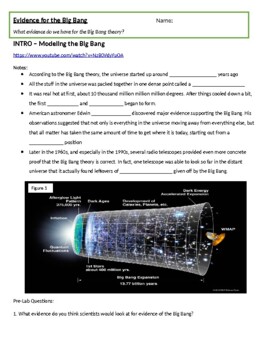
HS-ESS1-2 Bundle: Evidence for the Big Bang Labs and CER
Part 1 - Modeling the Big Bang with Balloons LabPart 2 - Evidence for the Big Bang (Intro to star spectra)Part 3 - Evidence for the Big Bang (Doppler effect and redshift)Part 4 - Evidence for the Big Bang (Cosmic Background Radiation)Part 5 - Claim, Evidence, ReasoningThis NGSS-aligned lesson bundle includes graphing and data analysis, hands on lab activities, videos, student modeling activities, spectroscopy and line spectrum analysis, scientific text analysis, and a claim, evidence, and reason
Subjects:
Grades:
9th - 12th
Types:
NGSS:
HS-ESS1-2

Experience the Moon Phases Discovery Lab
Students create and actually see the moon phases as they change the alignment between the Earth, Moon, and Sun. You only need the following supplies (styrofoam balls, popcicle sticks or sharpened pencils, and a light without a lamp shade) as seen in the picture, along with the Lab Sheet I have created to go with this hands-on activity. Could be a 1 or 2 day activity. Answer Key included. Very easy to set up and do. My students love this-as do I. Thanks and enjoy!
Subjects:
Grades:
1st - 6th
Types:
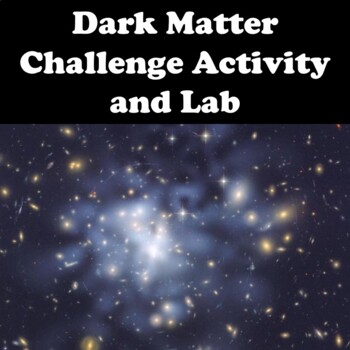
Dark Matter Lab (Editable)
Dark matter laboratory activity for high school astronomy. Show the effects of dark matter on gravity and light through tangible objects students can observe in a classroom. No computers or simulations needed! The product is an editable word document with no watermark, please click on the preview to view the full version of the product as a copyright pdf.This product includes two versions - a quick 15 minute activity and a 45 minute lab. Use whichever works best for your students. Materials list
Subjects:
Grades:
6th - 12th
Types:
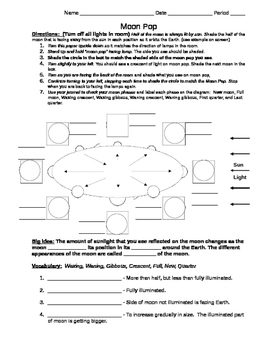
Moon Pops Moon Phases lab
Need a hands on activity to help teach moon phases? This activity gets students up and out of their seats and working with the moon to figure out moon phases. Students will need styrofoam balls on skewers and a lamp in the middle of the room or one lamp per group. As they rotate like the Earth, they see the phases of the moon on their moon pop. This activity lets students get into the moon phases diagram to better understand how the revolution of the moon causes the phases to be seen on Earth. A
Subjects:
Grades:
8th
Types:
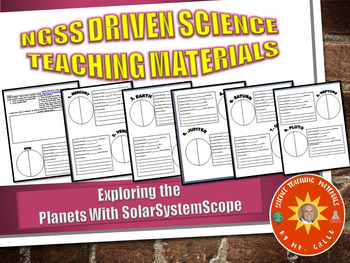
NGSS MS./HS. Space Systems: Exploring the Planets and Solar System Lab
NGSS MS./HS. Space Systems: Exploring the Planets and Solar System Lab aligns with High School and Middle School NGSS standards. Using www.solarsystemscope.com or the APP, students study the planets and fill in facts about each one. They also create drawings of the cross sections of the layers of each planet.
Included in these lesson materials:
-6 page packet with directions.
Teacher prep:
-Modeling on a smart board is suggested
-Copies for each student or in partners
-L
Subjects:
Grades:
6th - 12th
Types:

Oceanography Fun Activities, Labs, Directed Readings, Graphic Outlines
This Marine Science Bundle is meticulously curated to cater to your teaching needs, particularly if you are new to instructing Marine Science and seeking a comprehensive starting point. The bundle encompasses many resources tailored to Earth Science educators, guiding students to explore the significance of oceans, waves, tides, ocean floor topography, and surface and deep ocean currents. Within this extensive 3-4 week unit plan, teachers will find a rich assortment of lessons, projects, activ
Subjects:
Grades:
6th - 9th
Types:
NGSS:
MS-ESS2-3
, MS-ESS2-4
, MS-ESS2-6
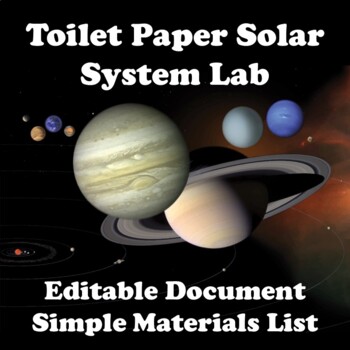
Solar System Toilet Paper Scale Lab (Editable)
Student will use mathematical modeling to create a scale model of the solar system and compare distances between planets.Please click this link to follow me on TPT: Problems, Experiments, and SolutionsPlease leave a review of this product to earn TPT credit (5 cents of every dollar spent on a product you purchase and review that is applied to your next TPT purchase).
Subjects:
Grades:
5th - 12th
Types:
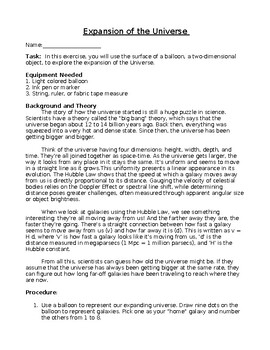
SES 4U_Unit 1 _Astronomy_Lesson 6_Big Bang Theory Student Lab
This is a lab activity to help the student visualize the expansion of the universe. All that is required is a balloon, marker, string and rulers. Students are required to submit a data table, scatter plot and analysis questions. This should take 1 period.
Subjects:
Grades:
12th
Types:
Also included in: SES 4U_Unit 1_Astronomy_Entire Unit

Eccentricity Lab for Astronomy & Earth Science (foci ellipse orbit)
6 page, straight forward lab that has students drawing ellipses using push pins and string. Students learn what eccentricity is and how it relates to orbits. They construct four different ellipses and relate it to the different planets. Lab utilizes the NYS Earth Science tables in some of the questions. For part C you do have to create a drawing of the Earth's orbit.
Subjects:
Grades:
8th - 10th
Types:
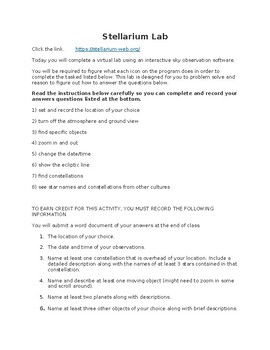
Astronomy: Stellarium Lab Activity
Today you will complete a virtual lab using an interactive sky observation software.You will be required to figure what each icon on the program does in order to complete the tasked listed below. This lab is designed for you to problem solve and reason to figure out how to answer the questions below.
Subjects:
Grades:
9th - 12th
Types:
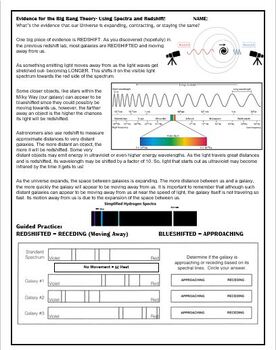
Using Spectra to Investigate Hubble's Law - Evidence of the Big Bang
Student's after a brief reading- explaining how scientists can gain knowledge about a stellar object's velocity, students use the amount of red-shift for each spectra to determine the velocity. Students then graph the relationship between the age of the galaxy and the velocity- showcasing Hubble's Law. Data driven activity to show evidence for the Big Bang Theory- along with some simple graphing practice.
Subjects:
Grades:
7th - 12th
Types:
NGSS:
HS-ESS1-3
, HS-ESS1-2
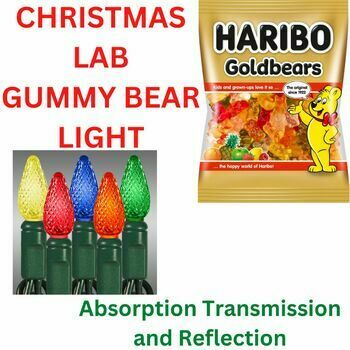
Christmas Light Absorption Transmission and Reflection Middle School Science Lab
Can you describe, scientifically, what is happening to an RGB Christmas light when placed in front of different colored gummy bear filters?A very easy prep, low cost, and fascinating lab exploring how we see colors. Perfect for Christmas science. Students will compare the absorption and reflection of Christmas lights on different colored gummy candies. It was developed to be conducted in one class period This activity improves students ‘understanding of the visible light spectrum and wavelength.
Grades:
7th - 9th
Types:
Showing 1-24 of 230 results





